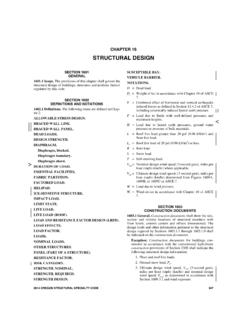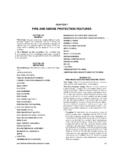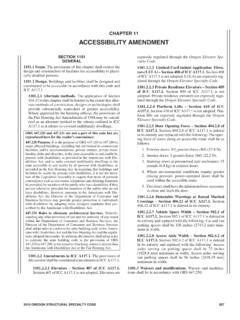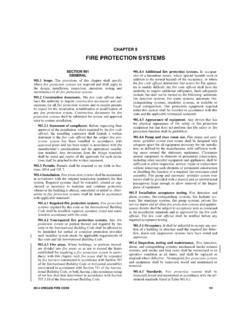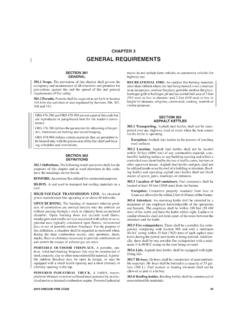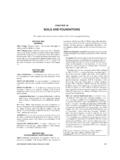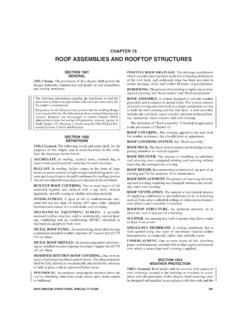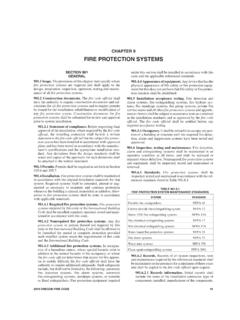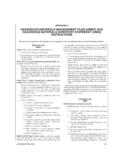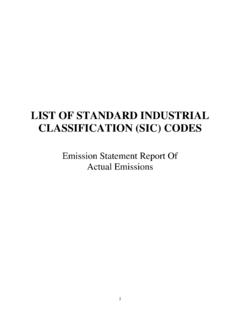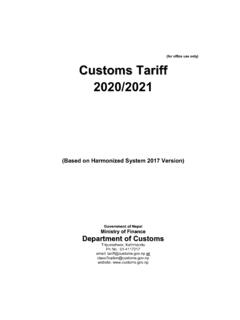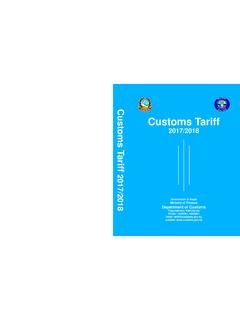Transcription of USE AND OCCUPANCY CLASSIFICATION
1 2014 OREGON STRUCTURAL SPECIALTY CODE51 CHAPTER 3 USE AND OCCUPANCY CLASSIFICATIONSECTION Scope. The provisions of this chapter shall control theclassification of all buildings and structures as to use General. Structures or portions of structures shall beclassified with respect to OCCUPANCY in one or more of thegroups listed in this section. A room or space that is intendedto be occupied at different times for different purposes shallcomply with all of the requirements that are applicable toeach of the purposes for which the room or space will beoccupied. Structures with multiple occupancies or uses shallcomply with Section 508. Where a structure is proposed for apurpose that is not specifically provided for in this code, suchstructure shall be classified in the group that the occupancymost nearly resembles, according to the fire safety and rela-tive hazard Assembly (see Section 303): Groups A-1, A-2, A-3,A-4 and A-52.
2 Business (see Section 304): Group B3. Educational (see Section 305): Group E4. Factory and Industrial (see Section 306): Groups F-1and F-25. High Hazard (see Section 307): Groups H-1, H-2, H-3, H-4 and H-56. Institutional (see Section 308): Groups I-1, I-2, I-3and I-47. Mercantile (see Section 309): Group M8. Residential (see Section 310): Groups R-1, R-2, R-3and R-49. Storage (see Section 311): Groups S-1 and S-210. Utility and Miscellaneous (see Section 312): Group USECTION 303 ASSEMBLY GROUP Assembly Group A. Assembly Group A occupancyincludes, among others, the use of a building or structure, or aportion thereof, for the gathering of persons for purposes suchas civic, social or religious functions; recreation, food ordrink consumption or awaiting Small buildings and tenant spaces.
3 A building ortenant space used for assembly purposes with an occupantload of less than 50 persons shall be classified as a GroupB OCCUPANCY . Small assembly spaces. The following rooms andspaces shall not be classified as Assembly occupancies:1. A room or space used for assembly purposes with anoccupant load of less than 50 persons and accessoryto another OCCUPANCY shall be classified as a GroupB OCCUPANCY or as part of that A room or space used for assembly purposes that isless than 750 square feet (70 m2) in area and acces-sory to another OCCUPANCY shall be classified as aGroup B OCCUPANCY or as part of that Associated with Group E occupancies. A roomor space used for assembly purposes that is associated witha Group E OCCUPANCY is not considered a separate occu-pancy.
4 Accessory to places of religious worship. Accessory religious educational rooms and religious audi-toriums with occupant loads of less than 100 are not con-sidered separate occupancies. Assembly Group A-1. Assembly uses, usually withfixed seating, intended for the production and viewing of theperforming arts or motion pictures including, but not limitedto: Motion picture theatersSymphony and concert hallsTelevision and radio studios admitting an Assembly Group A-2. Assembly uses intended forfood and/or drink consumption including, but not limited to: Banquet hallsCasinos (gaming areas)NightclubsRestaurants, cafeterias and similar dining facilities(including associated commercial kitchens) Taverns and Assembly Group A-3.
5 Assembly uses intended forworship, recreation or amusement and other assembly usesnot classified elsewhere in Group A including, but not limitedto:Amusement arcadesArt galleriesBowling alleysCommunity hallsCourtroomsDance halls (not including food or drink consumption)Exhibition hallsFuneral parlorsGymnasiums (without spectator seating)Indoor swimming pools (without spectator seating)Indoor tennis courts (without spectator seating)Lecture Page 51 Wednesday, May 14, 2014 9:13 AMUSE AND OCCUPANCY CLASSIFICATION522014 OREGON STRUCTURAL SPECIALTY CODEM useumsPlaces of religious worshipPool and billiard parlorsWaiting areas in transportation Assembly Group A-4. Assembly uses intended forviewing of indoor sporting events and activities with specta-tor seating including, but not limited to: ArenasSkating rinksSwimming poolsTennis Assembly Group A-5.
6 Assembly uses intended forparticipation in or viewing outdoor activities including, butnot limited to:Amusement park structuresBleachersGrandstandsStadiumsSE CTION 304 BUSINESS GROUP Business Group B. Business Group B occupancyincludes, among others, the use of a building or structure, or aportion thereof, for office, professional or service-type trans-actions, including storage of records and accounts. Businessoccupancies shall include, but not be limited to, the following:Airport traffic control towersAmbulatory care facilities Animal hospitals, kennels and poundsBanksBarber and beauty shopsCar washCivic administrationClinic, outpatientDry cleaning and laundries: pick-up and delivery stationsand self-serviceEducational occupancies for students above the 12th gradeElectronic data processingLaboratories: testing and researchMotor vehicle showroomsPost officesPrint shopsProfessional services (architects, attorneys, dentists, physicians, engineers, etc.)
7 Radio and television stationsTelephone exchangesTraining and skill development not within a school or academic Definitions. The following terms are defined inChapter 2: AMBULATORY CARE , Lockup facilities. Buildings containing lockup facili-ties, as defined in ORS (4), shall comply with the fol-lowing provisions: 1. Areas containing lockup facilities shall be separatedfrom other rooms, spaces or areas by an approvedsmoke barrier (see Section ). 2. The smoke control zone in which the lockup cells arelocated shall be provided with an automatic fire sprin-kler system complying with Chapter 9 requirements forGroup I-3 The smoke control zone in which the lockup area islocated shall be provided with an automatic smokedetection system installed in accordance with the FireCode Group I-3 occupancies.
8 4. The combined occupant load of the holding cells shallnot exceed 305 EDUCATIONAL GROUP Educational Group E. Educational Group E occu-pancy includes, among others, the use of a building or struc-ture, or a portion thereof, by six or more persons at any onetime for educational purposes through the 12th grade. Accessory to places of religious worship. Reli-gious educational rooms and religious auditoriums, whichare accessory to places of religious worship in accordancewith Section and have occupant loads of less than100, shall be classified as Group A-3 Group E, day care facilities. This group includesbuildings and structures or portions thereof occupied by morethan five children older than 21/2 years of age who receiveeducational, supervision or personal care services for fewerthan 24 hours per day.
9 Within places of religious worship. Rooms andspaces within places of religious worship providing suchday care during religious functions shall be classified aspart of the primary Five or fewer children. A facility having five orfewer children receiving such day care shall be classifiedas part of the primary Five or fewer children in a dwelling unit. Afacility such as the above within a dwelling unit and hav-ing five or fewer children receiving such day care shall beclassified as a Group R-3 OCCUPANCY or shall comply withthe Residential 306 FACTORY GROUP Factory Industrial Group F. Factory Industrial GroupF OCCUPANCY includes, among others, the use of a building orstructure, or a portion thereof, for assembling, disassembling, Page 52 Wednesday, May 14, 2014 9:13 AMUSE AND OCCUPANCY CLASSIFICATION2014 OREGON STRUCTURAL SPECIALTY CODE53fabricating, finishing, manufacturing, packaging, repair orprocessing operations that are not classified as a Group Hhazardous or Group S storage Moderate-hazard factory industrial, Group industrial uses which are not classified as FactoryIndustrial F-2 Low Hazard shall be classified as F-1 Moder-ate Hazard and shall include, but not be limited to, the follow-ing.
10 Aircraft (manufacturing, not to include repair)AppliancesAthletic equipmentAutomobiles and other motor vehiclesBakeriesBeverages: over 16-percent alcohol contentBicyclesBoatsBrooms or brushesBusiness machinesCameras and photo equipmentCanvas or similar fabricCarpets and rugs (includes cleaning)ClothingConstruction and agricultural machineryDisinfectantsDry cleaning and dyeingElectric generation plantsElectronicsEngines (including rebuilding)Food processing and commercial kitchens not associatedwith restaurants, cafeterias and similar dining facilitiesFurnitureHemp productsJute productsLaundriesLeather productsMachineryMetalsMillwork (sash and door)Motion pictures and television filming (without spectators)Musical instrumentsOptical goodsPaper mills or productsPhotographic filmPlastic productsPrinting or publishingRecreational vehiclesRefuse incinerationShoesSoaps and detergentsTextilesTobaccoTrailersUpholst eringWood; distillationWoodworking (cabinet) Low-hazard factory industrial, Group F-2.
